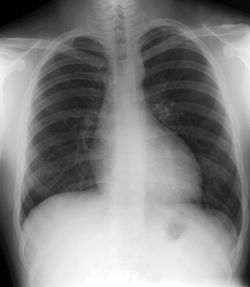MKSAP quiz: Diagnose progressive leg pain upon exercising
A 27-year-old man is evaluated for leg pain. The patient is moderately obese (BMI = 33) and had been sedentary until recently when he joined a health club; however, after only a few minutes on treadmill, he develops progressive pain in his both legs that resolves after a few minutes with rest. If he continues exercising, his left calf also becomes painful. The patient has a history of hypertension and a murmur, and his medications are lisinopril, hydrochlorothiazide, and atenolol. He has never smoked.
On examination, there is mild scoliosis. The blood pressure is 152/95 mm Hg bilaterally. Carotid arteries are brisk, and the lungs are clear. Cardiac examination reveals a 3/6 mid-peaking systolic murmur and 2/6 decrescendo diastolic murmur best heard at the left upper sternal border. There is no S3 or rub. Abdominal auscultation reveals a continuous transmitted harsh murmur. There is no tenderness, mass, or organomegaly. Femoral pulses are diminished, and no pulses are palpated in the feet. Chest radiograph is shown.

What is the most likely diagnosis?
A. Marfan syndrome
B. Bicuspid aortic valve with aortic coarctation
C. Aortic regurgitation and abdominal aortic aneurysm
D. Takayasu's arteritis
Answer and critique
The correct answer is B. Bicuspid aortic valve with aortic coarctation. This question can be found in MKSAP 14 in the Cardiovascular section, Item 52.
This patient has symptoms of bilateral claudication with a continuous murmur and evidence for aortic valve disease. He has several manifestations of aortic coarctation, including symmetric bilateral elevated blood pressure, continuous murmur, decreased pulses in the lower extremities, and symptoms of claudication in the absence of systemic atherosclerosis. The chest radiograph shows the aortic dilatation with rib notching due to extensive collateral circulation. Aortic coarctation is often associated with a bicuspid aortic valve, which, as in this patient, may present as progressive aortic stenosis and/or aortic regurgitation. The physical examination findings do not suggest Marfan's syndrome. He has no history of a previous severe systemic illness, making Takayasu's arteritis unlikely. Abdominal aortic aneurysm associated with diffuse atherosclerosis may be associated with symptoms of claudication, but would be unlikely in a young man.
Key points
- Aortic coarctation is associated with a continuous murmur (often posterior thorax) and elevated but equal blood pressure in both upper extremities.
- A bicuspid aortic valve is often seen in association with aortic coarctation, presenting with aortic regurgitation or aortic stenosis.





